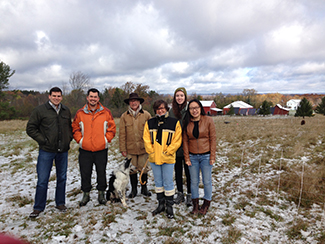CTG Investigating the Critical Factors of Food Traceability for Small Farms
 Governments, businesses, organizations and citizens around the world are increasingly seeking information about where exactly their food comes from. Of course, many of us pick up our food at a grocery store while companies purchase from distributors, but we know that is not where our food truly comes from; grocery stores and distributors serve as the middle man to get food from the farm to our table. While we can assume that much of it originates at a farm, that’s often all that is known because once product leaves a farm, it is notoriously difficult to ascertain the exact journey it takes before it ends up on our plate. Whether it’s to ensure our food is free of food-borne illness, or for economic development purposes, it’s becoming more and more important for stakeholders across the board that our food be traceable. This may sound like a straightforward process, but for small farms with limited capacity, any type of intricate tracing requirement can be crippling.
Governments, businesses, organizations and citizens around the world are increasingly seeking information about where exactly their food comes from. Of course, many of us pick up our food at a grocery store while companies purchase from distributors, but we know that is not where our food truly comes from; grocery stores and distributors serve as the middle man to get food from the farm to our table. While we can assume that much of it originates at a farm, that’s often all that is known because once product leaves a farm, it is notoriously difficult to ascertain the exact journey it takes before it ends up on our plate. Whether it’s to ensure our food is free of food-borne illness, or for economic development purposes, it’s becoming more and more important for stakeholders across the board that our food be traceable. This may sound like a straightforward process, but for small farms with limited capacity, any type of intricate tracing requirement can be crippling.
With funding from the National Science Foundation Early-Concept Grant for Exploratory Research, a CTG team is working to explore and better understand this issue, in particular the unique characteristics of small farmers as food producers. With a special focus on the “farm to institution” perspective in the NY Capital Region, CTG and research partner Professor of Biology Gary Kleppel of the Kleppel Lab for Agricultural Ecology and Sustainable Food Production at the University at Albany are analyzing the dynamics among small local farms, food distributors, institutional buyers, and other key government and non-government actors, and are also identifying the enablers and barriers for small farmers to participate in a whole-chain food traceability system.
The project, which began in October, will take about a year and will conclude with a preliminary data and technology architecture including data specifications, policies and governance that are responsive to interests to promote food supply chain integrity, including food source traceability, potentially applicable to small farms with less resources than their larger counterparts. The analysis results will provide new perspectives on data standardization as a different approach to traceability linking small farms to institutions. The case analysis will also help present improved methods for applying the concepts of traceability and product integrity to the risky, but highly significant, domain of small farms.